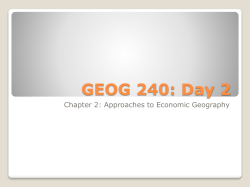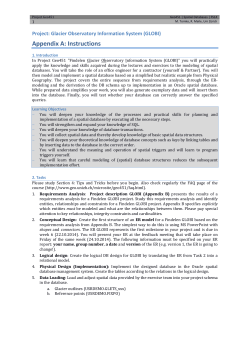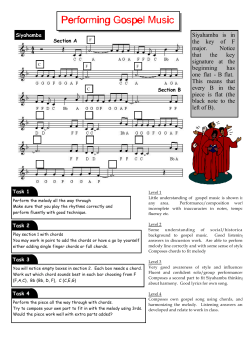
CO-445 Geovisualization is currently proposing a lot of approaches for spatial... SPATIAL ANALYSIS USING SONOROUS CARTOGRAPHY. SOME PROPOSITIONS. 1. CONTEXT AND OBJECTIVES
CO-445 SPATIAL ANALYSIS USING SONOROUS CARTOGRAPHY. SOME PROPOSITIONS. JOSSELIN D. UMR ESPACE, AVIGNON, FRANCE 1. CONTEXT AND OBJECTIVES Geovisualization is currently proposing a lot of approaches for spatial analysis in the field of animated and multimedia maps (Josselin & Fabrikant, 2003, Cartwright et al, 2007). Although it seems relevant to use our visual sense to comprehend phenomena in space and time (Adrienko, 2006), we maybe underestimate how useful can be hearing to complete our knowledge acquisition (Cauvin, 2008) and, more generally, our 'spatial thinking'. In this paper, we make some propositions to use sounds and chords added to statistical graphs to better understand the organization of space. We propose to couple a musical synthesizer to an statistical environment for developing interactive mapping applications. This method may also be used by blind or disabled people with deficient sight who compensate their handicap by emphasizing other personal capabilities, but also as a complementary geovisualization tool for any spatial analyst. As we know the importance of auditory objects to develop sensorial capacities from the cognition specialists (Brewster, 1994, O’Callaghan, 1999), it indicates that crossing our senses can improve our capacity to analyse spatial data on maps. On another hand, 'soundscape' can also be used to create ambiance which recalls or suggests an immersive environment (acoustic ecology). Those sounds can be natural acoustic noises, animal vocals, weather sounds, or even sounds created by humans (musical composition, conversations, industrial sounds, etc.) (Müller & Scharlach, 1999). It is not surprising that Murray Schaffer, who invented the soundscape concept in 1969, has been an educator and a music verbose composer. This shows how music and education are overlapping and this militates in favour of their joint use in spatial analysis, especially for teaching purpose about cartography. Let us also notice that some research works consist in mapping the urban sound (Schiewe J. & Kornfeld, 2009) or building geographical information systems dedicated to soundscape (Servigne et al., 1999). Although they are not directly linked to the research presented in this paper, these works bring an interesting point of view, because they enhance the sound, the noise or the auditive nuisances as important aspects of geographical information. In our project, we aim to include the audition in the process of spatial analysis. 2. METHOD: COUPLING INTERACTIVE MAPS WITH MUSICAL SYNTHESIZER/SEQUENCER We propose to set a dynamic bridge linking interactive maps we developed within the LispStat Environment (fig. 1, Josselin, 2003, 2005) with different possible synthesizer, Rosegarden and Hydrogen (fig. 2 and 3) on Linux environment. Those two synthesizers have been already tested in musical projects. For instance, a 4 octaves numerical xylophone has been built to define the midi canals and data exchanges. This instrument and a numerical keyboard can be used to tune the appropriate parameters and to design a particular chord associated to a set of observed spatial data. Using a classical Midi interface (Reveillac, 2005), it is possible to trigger several sound sequences, chords or sounds using an analogical signal. The idea here is to use this channel from spatial data to the synthesizer and to launch sounds or chords that are characteristic of the observed local space. Making interoperable LispStat with different GIS (SmallWorld, Arcview) has already been developed a few years ago using Data Dynamic Exchange (DDE) (Josselin et al., 1999). We now propose to apply a similar approach to join sonorous functions to spatial analysis. How will it work? Each time the user explores a window using its mouse on a map or, in this particular case, on an image, (s)he will get back a composed signature from the available geovisualization tools: statistical distribution of pixel values, co-occurrence matrix, multi-directional variogram (Josselin, citer). Concretely, all these signatures can be transformed on a set of quantitative data, the stake becoming then to give an auditive sense to these signatures. Those are to be 'translated' in a musical language, namely in a specific sonorous pattern. The question then is: how to design a relevant chord or sound to describe the spatial pattern and moreover to make it different from the other possible patterns on the explored map. Beyond the need of finding homogeneous and recurrent patterns in space, it can also be very interesting to detect spatial discontinuities, i.e. some noticeable change in the pattern (expressed by chord or sound changes). There are indeed two different ways to design this sonorous pattern. The first one is proposed by the soundscape field: the sounds must represent as obviously as possible the real world. A river has to 'sound' as a water move and lap, a forest has to be quiet with little rustles and animal noises. The advantages of such an approach is that the auditive representation of the space is very efficient. But the problem is that the pattern has to be rightly 'labeled' as a type of land/soundscape. It is the same at the end of a supervised or unsupervised classification in image analysis, for instance: we know what is where on the map. Indeed, in spatial analysis, we often encounter mixed areas, and even sometimes undefined places, because our means to identify them are not enough reliable. We believe the sonorous functions can help in finding the spatial analysis patterns, upstream the final cartography or classification. Moreover, we actually are not sure that the chords assigned to the spatial patterns must be close to real-life soundscapes. At a first stage of reflexion, we propose a statistical approach to design the chords and make them different from each others, due to the attributes of the objects included in the pattern. In our meaning, a sonorous pattern is a kind of chord, but it doesn't often respect the musical harmony rules. It even may be 'dis-harmonic', because some combination of instrument notes can be out of any implicit scale. It also only involves the pixel values distribution, but not the loudness, the pitch or the timbre (Dictionnaire de la musique, 1957). However, all these parameters can be set using a numerical approach such as the classical midi channel. In this proposition, we won't develop the different ways we intend to explore in order to include these parameters. We now propose to focus on the description of statistical distribution of spatial data. When the user is moving the little window (with the mouse) in figure 1, the computer sends back a first signature which is a set of pixel values, drawing a statistical distribution. This histogram plots the frequency of values, discretized in several classes. Thus, we use these two complementary dimensions to make discriminant chords, simple combinations of notes and instruments. Each class in the distribution is considered as an instrument, and the hight of each class determines its note (fig. 4). For instance a violin (first instrument) can play a F, due to its high frequency. A cello (second instrument) can play a G, and so on. An homogeneous area with similar pixels sounds in unison. A bimodal asymmetric distribution enhances two instruments providing two main notes. A more complicated distribution generates specific chords. On another hand, when a value misses (resp. a geographic object or a class), the set of instruments changes, making a different local 'orchestra'. While moving the local window on the image, the user can find local peculiarities or spatial discontinuities and gradients between them. 3. RESULTS AND PERSPECTIVES At this time, our model has not been yet implemented within a dynamic link between the synthetizers and the exploratory spatial data tool we developed in LispStat. Both parts have been tested, separately. Some experiments have been made on artificial chords according to observed data, using Rosegarden and Hydrogen softwares. Some of them sounded good, others were discordant ans so horrible to hear. This leads to the problem of our cultural and musical background. This tool has to be comprehended as a numerical (but not necessarily aesthetic) tool for spatial data exploration. Nevertheless, we intend to include some harmonic considerations in building the artificial chords, based on music theory. Our research intends to build a theoretical and methodological framework of 'geo-hearing'. There is still open questions, such as the influence of the art and culture on the way we perceive the statistical chords, the effect of the discordance, the role of half-tones, the mixture of different instruments and its signification, etc. Also some concrete tests must be processed to assess whether or not this new capacity is really useful in spatial analysis, in which context and for which kinds of users (usability tests, Nielsen, 1990, Lazar, 2007). Fg. 1. Exploratory Spatial Data Analysis using LispStat: a useful way for extracting spatial patterns according different points of view on space (distribution of pixel values, organization of pixels with a cooccurrence matrix and regularities in scales viewed and identified by a dynamic variogram). Fig. 2. Rosegarden is a complete free software to write partitions, play music compositions, including a synthesizer to play different instruments. Fig. 3. Hydrogen is a 'rhythm box' to launch recorded percussion sounds. A set of 32 separated instruments can be defined and played in variable tempos and musical environments. Fig. 4. A first simple method to build 'statistical chords': : the pixel values are counted and plotted in a distribution; the frequency provides a note and the class determines the instrument. REFERENCES - Andrienko N. & Andrienko G., 2006, Exploratory Analysis of Spatial and Temporal Data: A Systematic Approach, Springer. - Brewster, S.A., 1994, Providing a structured method for integrating non-speech audio into humancomputer interfaces. PhD Thesis, University of York, UK. - Cartwright W., Peterson M.P., Gartner G. (Eds), 2007, Multimedia cartography, Springer. - Cauvin C., Escobar F., Serradj A., 2008, Cartographie thématique 4 des transformations renouvelées, Traité IGAT Hermès lavoisier. 198 pages. - Dictionnaire de la Musique, 1957, en 2 tomes, Larousse, Paris. - Josselin D., Chatonnay P., Guerre L., Dancuo B., 1999, Lien dynamique entre ArcView et Xlisp-Stat (LAV-STAT) : un environnement interactif d'analyse spatiale, Actes de la Conférences ESRI 29 et 30 septembre 1999, 10 pages. - Josselin D. 2003, Spatial Data Exploratory Analysis and Usability, Codata, Data Science Journal, vol. 2, 2003. Special issue “Spatial Data Usability” (Eds. : Monica Wachowicz & Gary Hunter) - Josselin D., 2005, Interactive Geographical Information System using LISPSTAT : prototypes and applications. Journal of Statistical Software. February 2005, Volume 13, Issue 6, 20 pages. - Josselin D., Fabrikant S., (Eds), 2003, N° spécial « cartographie animée et interactive », vol. 13, n°1/2003, Revue Internationale de Géomatique, Hermès, Lavoisier, Paris. - Lazar J. (Ed), 2007, Universal Usability, Designing Computer Interfaces for Diverse Users, Academic Press, Whiley & sons, NY. - Murray Schafer R., 1969, The New Soundscape, Don Mills, Toronto. - Nielsen J., 1990, Usability Engineering, Academic Press. - O’Callaghan C., Object Perception: Vision and Audition, 2008, Philosophy Compass, 3/4, pp. 803–829. - Reveillac J.-M., 2005, Audio-numérique: de l'acquisition à la diffusion, Dunod, Paris. - Schiewe J., Kornfeld A.-L., 2009, Framework and Potential Implementations of Urban Sound Cartography, 12th AGILE International Conference on Geographic Information Science 2009, 8 pages. - Servigne S., Laurini R., Kan Myoung A., Li Ki J., 1999, First Specifications of an Information System for Urban Soundscape, in ICMCS '99: Proceedings of the IEEE International Conference on Multimedia Computing and Systems.
© Copyright 2025





















